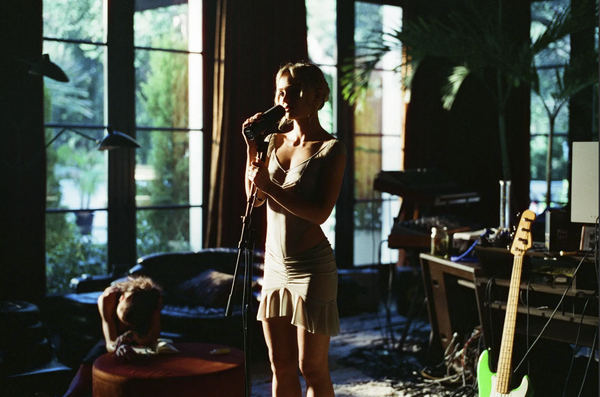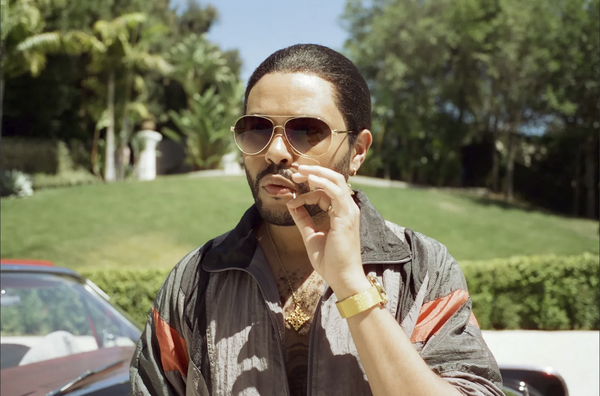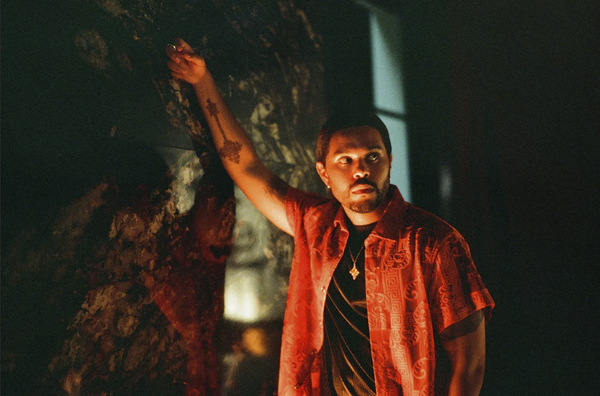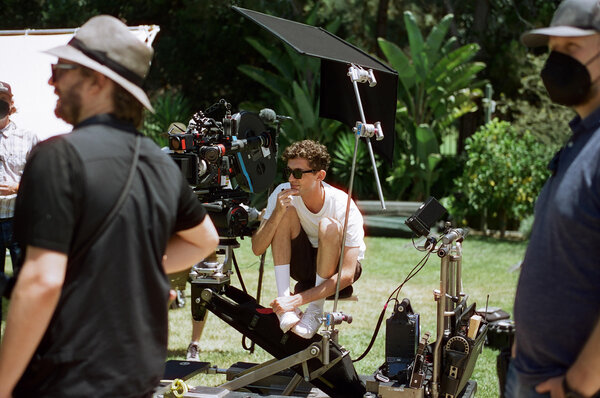The DoP Arseni Khachaturan talks about his work on the HBO serie "The Idol", directed by Sam Levinson
Sex, Lies and Ektachrome, by François ReumontNew York based cinematographer Arseni Khachaturan was chosen by Sam Levinson to boldly begin the series, then handed over the cinematography to Marcell Rev HCA, ASC, who shot both seasons of "Euphoria".
A series about celebrity and lies, the release of which was preceded by much controversy. Before these first two episodes were even revealed at Cannes, an article in the Rolling Stones magazine described the making of the series as chaotic and out of control. Initial director Amy Seimetz’ work s being turned down by the channel, who took the costly decision to reshoot the whole thing. Then the Cannes premiere was no exception, triggering a number of criticisms about its openly provocative quality in a post-Weinstein world. (FR)
After a nervous breakdown derailed Jocelyn’s last tour, she’s determined to claim her rightful status as the greatest and sexiest pop star in America. Her passions are reignited by Tedros, a nightclub owner with a sordid past. Will her romantic awakening take her to glorious new heights or the deepest, darkest, depths of her soul ?
You arrived on the project after the HBO decision to reshoot the entire show... Thats an unusual situation isnt it ?!
Arseni Khachaturan : The project started two years ago, under the aegis of Sam Levinson who was the executive producer, and was in the process of completing the second season of "Euphoria" at the same time. When the decision was made to start all over again and Sam took over the reins, he asked me to team up with him, the situation was quite tense... Sam even asked Abel Tesfaye if we could shoot in his own house ! That’s how we started from scratch, from the new script, without looking at what had been done before.
So Jocelyn’s house is Abel’s house for real ?
AK : Yes, his house was the main set for the shoot. Abel was naturally very involved in the project, as a co-producer. I was also amazed by Lily Rose Depp’s performance. Not only does she have an incredible face to film, she’s also a great and very humble person to work with.

From the start, the storytelling skills, between the multiple characters and their various points of view, is captivating...
AK : Sam is very good at this. On the series we were regularly confronted with both very intimate sequences and scenes involving up to a hundred people on set. For those big scenes with many actors, first, he’d set things up, according to the architecture of the scene. Once things were established, we would separate the possible angles and shots with two or three cameras working simultaneously. Then, he would move from one camera to the other, twirling around and giving us instructions. I can still hear him telling me ’look here, this is what I want’. The idea was to create the action first, the event, then to extract from it what he needed, what seemed to make sense to say on screen. I’d say that he’s a master in this way of leading.
You use a lot of telephoto lens for this kind of scene...
AK : Yes, in the opening sequence of the first episode, when Jocelyn’s entourage hears about the photo that leaked on the web, the main issue was to see who was looking at who and who was listening to whom... Is Jocelyn aware of this, or does she not suspect anything ? The use of a long lens contributes greatly to the success of the scene. This was also present in the music video shooting sequence in episode 2. With these multiple points of view, shot from far away on the telephoto lens, we never really know who is watching ; who is captain of the ship in that moment, and if there even is one. This kind of permanent uncertainty gives a very interesting style to the image. Who can be trusted in this series...who can be followed ? It will be up to the viewers to make their own map...
Was it easy to shoot such a story, surrounded by pop stars ?
AK : Of course Abel was there... but there wasn’t just him. You might have recognised Mike Dean, – a renown record producer (who notably produced the Weeknd), who gives life to Jocelyn’s manager on screen. As most of them were in front of the camera, acting, they weren’t there to only work as technical advisors. It made the project very balanced, and being observed by such people gave us a lot of confidence.
Were you able to film in sequence ?
AK : We tried to shoot as much as we could in chronological order, but as always the availability of certain cast made us switch from one episode to another. After the preparation, we started the series with the first two episodes. I had to leave during the third episode because I had a previous long-standing commitment to another film. Marcell Rev took over for the rest of the shoot. Drew Daniels also took over for additional photography in the end. For visual inspiration, we watched a lot of films with Sam. But I would say that the style emerged by itself when we started shooting in Abel’s house. Sam is extremely specific visually. It’s easy to follow him and to propose things for the camera with him.
Just as the second season of “Euphoria”, “The Idol” was also shot on film...
AK : Sam likes to shoot on film, and we didn’t even think of shooting differently. Most of the films I’ve shot before have been done this way. It becomes a natural order of things.
We did some tests, and chose to shoot in 250D so as not to have too much grain, and create this glamorous lush ’Hollywood image’ for the scenes that needed it. And the 500T for night work and interiors. We also used a lot of Ektachrome 100D, which gave a really unique colour rendering and contrast. Sam had shot with this reversal stock the second season of "Euphoria", and really liked its unusual rendering. It was also easier for us technically, because Foto Kem laboratory was already working on this, be it on the process or on the digital scan. Tom Poole from Company 3 deserves special credit, because honestly, when you load the reels out from the lab, they don’t necessarily come out very well on screen. As a cinematographer, you shouldn’t expect everything to necessarily be right from the start ! As a colorist, Tom has a real skill, and it helped a lot since he already worked on it with Marcell and Sam on "Euphoria".

How did you choose to divide the different stocks ?
AK : We shot most of day exteriors with Ektachrome. And for some indoor daytime scenes, but for night scenes it was quite complicated due to the lack of ISO speed and low latitude. Some unexpected things were happening during the slow motion shots, shot at 150fps, on Ektachrome. This reversible stock is thicker than the stock that is usually used with these cameras. It made the camera gate very hot... smoke was eventually coming out of the camera body when unloading it !
It’s a film about the place almost as much as it is about the characters...
AK : On this project, we pre-lit the whole house, so that I could control everything live. It was a really big mansion, all white, very Californian. Controlling the lighting inside, especially because we were shooting reversal, was essential. The whole set was connected to a DMX board in a room. This enabled us to move very quickly from one scene to another on set. In the sequences with a lot of actors, we would light the place first, and as we’d move closer, we’d obviously install additional small sources.
For the scenes in the private studio... it looks as though you shot with available light.
AK : Shooting in this studio was like filming in a fish tank. There were glass walls on all sides, reflecting the slightest spotlight in all directions. We originally thought of shooting somewhere else, to avoid this nightmare. But that room is at the centre of Abel’s house, it’s like the heart of the place. We agreed that we couldn’t do without it.
These scenes had to take place in that particular room. As a result, most of the lighting came from sources on the set : the computer screen, the small lights that illuminate the mixing desk etc. In this context, the place definitely sets the drama much more than the light.
What sources did you favour on this show ?
AK : For the day exteriors, it was really classic, with big HMIs. Nothing too exotic. LED balloons for night exterior work.
For the interiors, Eddie Reid, my gaffer, introduced me to Fillex LEDs, particularly the Q10 and Quad models, which became very important. I also used a lot of small DMG Dashes that can be stuck just about anywhere, and which have an autonomy of a good ten hours. very useful tools. For stronger ambient light, I like the Cream Source products, such as the Vortex. So we mainly used LEDs, as they are nowadays a necessary tool to have on set in order to be precise with the colour and intensity.

Some scenes were extremely colourful, and very saturated.. how did Ektachrome react in those conditions ?
AK : For the colour palette, Ektachrome worked very well on reds and blues, but not so well on greens. In fact it tended to cool down the greens, and gave an emerald colour that I didn’t like very much. This kind of film generally reacts very strongly to light variations. Shooting in direct sun for example, makes the contrast become insane.. and in grey weather everything suddenly becomes very dull and lifeless ! It is important to find the right balance between the two, and once mastered, it becomes an exciting tool to work with.
Let’s talk about optics... again, was it the choice of high contrast film that lead you to this direction ?
AK : We tried many different lenses to see which ones would work with this kind of film. We chose the Leica Summilux series, along with a "Classic Cron" series, which is actually a slightly detuned Summicron series. I knew of this Duclos made set because of Rufus Burnham at The Camera Division in Burbank. They have the classic Summicron look, but with a little less sharpness, and a more velvety texture. A little less contrast too... we used them mainly on sunny exteriors to break the contrast, the Summilux being used more indoors and at night for a sharp and glamorous image.

We also used a lot of Angenieux Optimo zooms, often with doublers. In the scenes with a lot of characters, we often worked with three cameras. The main camera was on a prime lens, while the other two were zooming in and out as needed. Sam really wanted a marked zoom effect. For example, starting at 24mm with a very wide shot of the house, and ending at 290mm with a very close shot of Tedros smoking a cigar on the balcony. It’s a very classic, very 70s Hollywood style. And that style is found quite a lot throughout the series.
Some DOPs often make an analogy between rhythm and light... On a film like this, did you feel this ?
AK : To me, this series was like a symphony. That’s how I think Sam directed it. We weren’t listening to music on set for inspiration or to find rhythm, but it was right at the heart of the project. I remember moments where we would all meet in the studio with Mike Dean and Ramsey, who co-wrote Jocelyn tracks. We’d sit down, and they would just go off into jam. Sam would listen with us... Those jams could go on for a really long time. We would watch them searching for the musical essence. That sums up the spirit of “The Idol”. We were in a continuous search. When we were in Abel’s house, we were living the creation process. I can’t describe how magical it was. To me, it felt unique to practically never leave that creative space for four weeks. When I had to leave... Man, I was completely disoriented.
Isn’t surprise also an important word for Sam Levinson ?
AK : It is indeed a very important one. One of the many facets of Sam’s talent. Even on the shoot, there could be surprises for us. For example, he could adjust or change a scene the morning of a shoot by incorporating this or that character, just because he had a new idea. That’s why shooting in a semi-chronological order was important for us, and it was for the best, giving energy to the whole team. Working with someone so reactive and creative, one has to push oneself.
Tell me about that scene in the second episode, when Tedros’ gang arrives at Jocelyn’s house, and Chloe’s character suddenly starts playing a piano sonata...
AK : Oh yes, that scene ! That was an improvisation. Susanna Son, who plays Chloe, like many other members of the cast, is a very talented singer. I remember this moment, we were preparing another sequence in the house... and suddenly we heard Susanna playing the piano in a corner. Abel and Lilyet Moses joined her, and the musical jam started. This is exactly what I was describing to you : at the heart of this creative environment, as the director of photography, it was up to me to react quickly. It’s the kind of moment which needs to be caught immediately, realising that something’s happening right then and now. I had to be focus and aware of what was going on around me at all times.
What did you learn on this film ?
AK : Always trust the director and the creative process he or she has initiated. Stay vigilant.
It may sound a bit trivial, but I’m really proud of what everyone did on “The Idol”, both the performers and the crew. Abel, whose house we filmed in, was an amazing host. In return, we did everything we could to show him our gratitude.
(Interview conducted by François Reumont and translated from French by Chloé Finch, for the AFC.)
"The Idol"
Director : Sam Levinson
DOPs : Arseni Khachaturan, Marcell Rev, Drew Daniels
Production Designer : Charlie Campbell
Costumes : Natasha Newman Thomas
Editing : Julio Perez
Music : The Weeknd, Ramsey
 En
En Fr
Fr





